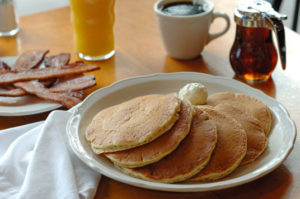All breakfasts are not created equal but you can count on maple syrup on the table at pancake restaurants near me.
What do all the pancake restaurants near me have in common? Well, pancakes are the obvious answer. But what about maple syrup? What would our pancake breakfast be without this sweet, tasty topping? Not nearly as delicious, that’s for certain.
Indigenous people living in northeastern North America were the first to tap trees and produce maple syrup. This practice was continued by European colonists. Somewhere along the line some ingenious person had the idea to use maple syrup as a topping on pancakes and now the combination is iconic. It would be a challenge to find pancake restaurants near me, or anywhere around the globe, that isn’t serving maple syrup.
Here are some fun facts about maple syrup to ponder over your next stack at The Original Pancake House in Denver.
- 75% of the world’s maple syrup is produced in Quebec, Canada. In the U.S. New York and the New England states also produce a large amount.
- It takes 40 GALLONS of raw sap to make 1 gallon of maple syrup.
- “Sugaring season,” when sap is harvested and made into syrup, only lasts for about six weeks in late winter and early spring.
- The building where the sap is boiled down to syrup is called the “sugar shack.”
- The Sugar Maple is the best tree for producing syrup.
- The tree must be 10 inches in diameter and 40 years old before it can be tapped to collect sap.
- Once a tree has been tapped, that same hole can’t be used again. Trees have a natural healing process called “walling-off” that prevents a hole from being used a second time. The tree can be tapped again, but in a new spot.
- Tapping a maple tree does not harm it and some have been tapped for more than a century.
- Maple syrup has more calcium than milk (per unit volume) and more potassium than bananas (per unit weight). It also contains manganese, magnesium, phosphorous, and iron, as well as several vitamins. How about that for a healthy breakfast!
